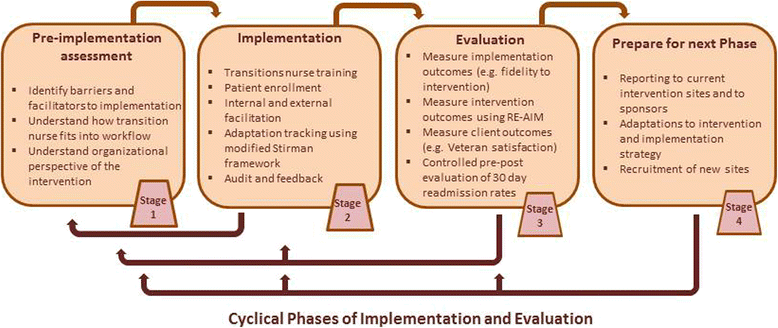Implementation and dissemination of a transition of care program for rural veterans: a controlled before and after study
- PMID: 29058640
- PMCID: PMC5651587
- DOI: 10.1186/s13012-017-0653-1
Implementation and dissemination of a transition of care program for rural veterans: a controlled before and after study
Abstract
Background: Adapting promising health care interventions to local settings is a critical component in the dissemination and implementation process. The Veterans Health Administration (VHA) rural transitions nurse program (TNP) is a nurse-led, Veteran-centered intervention designed to improve transitional care for rural Veterans funded by VA national offices for dissemination to other VA sites serving a predominantly rural Veteran population. Here, we describe our novel approach to the implementation and evaluation = the TNP.
Methods: This is a controlled before and after study that assesses both implementation and intervention outcomes. During pre-implementation, we assessed site context using a mixed method approach with data from diverse sources including facility-level quantitative data, key informant and Veteran interviews, observations of the discharge process, and a group brainstorming activity. We used the Practical Robust Implementation and Sustainability Model (PRISM) to inform our inquiries, to integrate data from all sources, and to identify factors that may affect implementation. In the implementation phase, we will use internal and external facilitation, paired with audit and feedback, to encourage appropriate contextual adaptations. We will use a modified Stirman framework to document adaptations. During the evaluation phase, we will measure intervention and implementation outcomes at each site using the RE-AIM framework (Reach, Effectiveness, Adoption, Implementation, and Maintenance). We will conduct a difference-in-differences analysis with propensity-matched Veterans and VA facilities as a control. Our primary intervention outcome is 30-day readmission and Emergency Department visit rates. We will use our findings to develop an implementation toolkit that will inform the larger scale-up of the TNP across the VA.
Discussion: The use of PRISM to inform pre-implementation evaluation and synthesize data from multiple sources, coupled with internal and external facilitation, is a novel approach to engaging sites in adapting interventions while promoting fidelity to the intervention. Our application of PRISM to pre-implementation and midline evaluation, as well as documentation of adaptations, provides an opportunity to identify and address contextual factors that may impede or enhance implementation and sustainability of health interventions and inform dissemination.
Keywords: Adaptation; Dissemination; Implementation; PRISM; Rural health; Transitions of care; Veterans.
Conflict of interest statement
Ethics approval and consent to participate
This study is a designated program evaluation by the VA Office of Rural Health. This project is not a human subject research.
Consent for publication
Not applicable.
Competing interests
All authors declare that they have no competing interests.
Publisher’s Note
Springer Nature remains neutral with regard to jurisdictional claims in published maps and institutional affiliations.
Figures

References
-
- Coleman EA, Parry C, Chalmers S, Min S-J. The care transitions intervention: results of a randomized controlled trial. Arch Intern Med. 2006, 1822;166(17) doi:10.1001/archinte.166.17.1822. - PubMed
Publication types
MeSH terms
Grants and funding
LinkOut - more resources
Full Text Sources
Other Literature Sources
Medical

